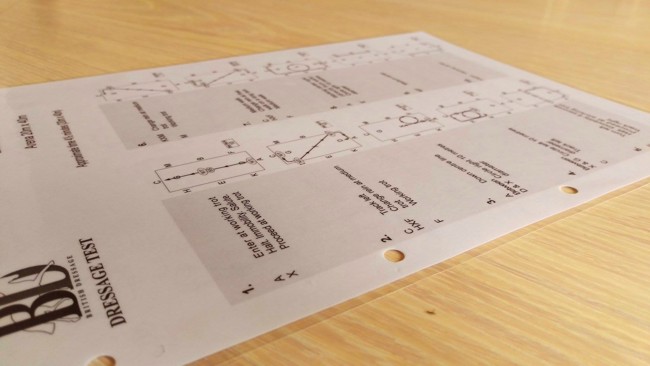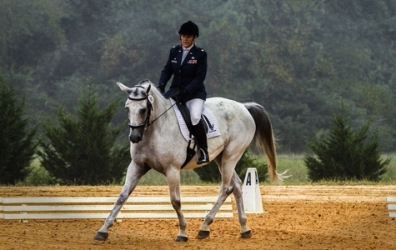 We all have our favourite ways of learning a dressage test, and usually riders stick to one or two methods. However, the more choices you have in learning a test and using different options, the more likely it is you will be able to remember it, even under difficult or stressful conditions. I have here a list which I not only use myself, but ideas that have been hugely helpful for the riders I work with. These cover many different learning styles and include practical suggestions and mental strategies with the help of NLP, Hypnosis & Visualisation.
We all have our favourite ways of learning a dressage test, and usually riders stick to one or two methods. However, the more choices you have in learning a test and using different options, the more likely it is you will be able to remember it, even under difficult or stressful conditions. I have here a list which I not only use myself, but ideas that have been hugely helpful for the riders I work with. These cover many different learning styles and include practical suggestions and mental strategies with the help of NLP, Hypnosis & Visualisation.
1. Start to learn your test a few weeks before the competition. The longer you have to learn it, the better you will feel and the less stress will be associated with competing. Remember, anxiety and tension will affect not only you, but your horse. If you know the test by heart, that reduces your stress levels.
2. I recommend you buy laminated test sheets with diagrams. You can buy these in a folder from British Dressage Online Shop or at Dressage Diagrams. This makes it easier to ‘see’ where you are going.
3. Draw the test out over and over again. Different coloured markers for different paces. You can get A4 boards with the markers already printed out. Draw out the test, wipe it off. Repeat.
4. Look at the test as a whole and run through it a couple of times, just to get the ‘feel’ of it before you start learning.
5. Break it up into chunks/sections and make the chunks small. Memorize the small chunk. Have a cup of coffee, think about it again. Do that a few times in a day.
6. Ride each ‘chunk’ in your mind. You will have already decided which is the best way to turn into the arena, depending on which way your horse turns more easily. Imagine sitting on your horse. You look up to see the best place for the turn, as you make the turn, you head directly for C , riding straight to that marker and the judge. As you do this, also imagine you can feel what it’s like to turn onto the centre line at A and ride that straight line to C. Will it be sitting or rising trot? How will that trot feel under you? How do your legs feel whilst they create and maintain the energy and straightness?
7. You are memorising not only the test as a pattern on a sheet, but more importantly, you are memorising what it looks and feels like, and this will all sink into your subconscious. So put in as much as you can. As you approach C, what will you be doing to make that turn? How will that feel, with your hands, your legs, your body?
8. Continue in small chunks all the way through the test, running it bit by bit and only moving on to the next piece when the first is memorized. It may seem a faff to do all this, but this is one way to really ‘know’ your test. If something happens half way through a test (that’s nothing to do with you), you are much more likely to just be able to continue with the test as you ‘know’ it.
9. Using hypnosis can really help. This is where you deepen that visualisation into more of a trance state. A good time for this is when you go to bed. Have your test near you. Make sure you are not going to be disturbed. Turn the light and your phone off. ‘See’ yourself riding the test as if you were on your horse. Whilst you are relaxed, the patterns and images will drift further into your subconscious. This happens naturally and effortlessly and is reinforced when repeated.
10. Each night, practise the hypnosis session. If you always fall asleep, then simply do this at another time of the day, perhaps sitting in a chair.
11. Find a clear area of your living room, yard, etc. Simply ‘ride’ the test in this area on foot.  Be very clear where the markers are and what movements you are doing where. You are showing your subconscious mind the test and it’s all going in to be memorised, (which is what you want to happen) so be accurate when you ‘ride’ it!
Be very clear where the markers are and what movements you are doing where. You are showing your subconscious mind the test and it’s all going in to be memorised, (which is what you want to happen) so be accurate when you ‘ride’ it!
12. If you are fortunate to be able to ride another horse that is not competing, then ride the test on that horse. This will give you the added benefit of doing the complete test without the danger of your own horse anticipating the movements.
13. If you are a person that learns really well by listening to something , call out your test and record it on your phone. Listen to it whenever you can. If however you start to ‘tune out’, then you need to do this in another way. I suggest sing the test! You can sing it to yourself again when you are actually competing (do remember not to do this out loud!).
, call out your test and record it on your phone. Listen to it whenever you can. If however you start to ‘tune out’, then you need to do this in another way. I suggest sing the test! You can sing it to yourself again when you are actually competing (do remember not to do this out loud!).
14. When you get to the venue, you can watch the riders before you, but make sure you watch one or two well before your test. If you watch only the last rider, and they go wrong, then that may very well affect you negatively. I suggest when you send your entry in, you ask for a late time. Get there early and watch a few tests. You want to feel that you can easily predict the next movement (almost as if you are ‘calling’ the test for them).
15. Warm up then go through your test on your horse before you go in if you want. You are only looking to reinforce the pattern, not necessarily ride all the movements.
16. Often you can find your test on YouTube. Make sure it's the right year! Choose high-scoring tests if you can. It can help to actually see what the test or movement should be and you can play it as often as you want.
17. Using a caller. Most likely you can ask someone at the venue to call.  Perhaps you are lucky enough to have someone coming with you who is prepared to call. Now this can be a real bonus, or it can put you off your test completely. You still have to know your test as callers actually can go wrong sometimes. But the main thing here is you must have some experience of listening to a caller and riding a test. It can be quite different. It can be a great back up, or a distraction, and you don’t want to find out which when you are actually in there. So practise this with someone at home first.
Perhaps you are lucky enough to have someone coming with you who is prepared to call. Now this can be a real bonus, or it can put you off your test completely. You still have to know your test as callers actually can go wrong sometimes. But the main thing here is you must have some experience of listening to a caller and riding a test. It can be quite different. It can be a great back up, or a distraction, and you don’t want to find out which when you are actually in there. So practise this with someone at home first.
Remember...if you go wrong, it’s only 2 penalty points! It’s worth just stopping and giving yourself a moment to work out where you are in the test, what happens in the next few moves. If in doubt, walk over or shout to the judge and ask. This is far better than going blank then trying to guess.
Copyright Amanda Kirtland-Page 2016
